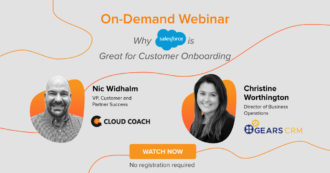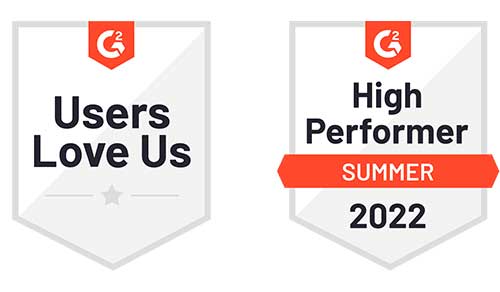 Webinar
Webinar
- Solutions
- Customer Onboarding
- Customer Success
- Professional Services Automation
- Project Management
- Project Portfolio Management
-
Solutions
-
Features
- Why Cloud Coach
- Customers
-
Resources

Business owners and marketers become obsessed with different metrics and KPIs to see how successful they are. Traditionally, your focus is firmly set on new customer acquisitions. This is when you attempt to draw in as many new customers as possible, with the obvious goal of increasing sales.
However, there’s something else you should be concerned with: customer retention.
It’s a critical element of every business, yet is often overlooked. In this guide, we’ll explain precisely why customer retention is important, along with more information on the topic to help you improve your customer retention rate. Before we dive deeper into that, there’s one key question to consider…
What is customer retention?
Customer retention is a self-explanatory metric with a focus on your company’s ability to keep customers over an extended period. In other words, it’s a way of measuring customer loyalty. If you have a large base of loyal customers, your retention rate will be extremely high. People come to your business once, and then keep coming back for more.
While most people use the term “customer retention” it is sometimes referred to as the churn rate. This is more of a technical term that’s defined as the rate at which customers stop doing business with an entity.
Understanding and being aware of what customer retention means is the first step. Next, you need to consider why this particular metric is so important. The following section will walk you through all of the major points to explain why you need to take it seriously.
ADDITIONAL LINKS
Why is customer retention important?
On a fundamental level, customer retention is important as it tells you so much about your organization.
As a brief overview, here’s how you’ll benefit from a good customer retention rate:
- Gain new customers and keep them around for longer
- Improve customer loyalty
- Increase your ROI
- Save money throughout your business
- Boost your brand authenticity & trust amongst other consumers
Focusing on customer retention helps you generate a large base of customers. You can draw in new faces, but the key is that you are keeping as many of them around as possible. The longer a customer stays with your business, the more likely they are to keep spending money. This isn’t just an anecdote plucked out of thin air – there’s evidence to support this claim. Research has shown that loyal customers are far more likely to spend more money than newer customers.
Put simply, if you don’t focus on retaining customers, you can miss out on a lot of ongoing sales. Every business should try to improve customer loyalty as best as they can, and developing strategies to upgrade your retention rate will help with this. In turn, it leads to the third bullet point of increasing your ROI.
The same study we linked above showed that increasing your customer retention by as little as 5% can boost revenue by up to 95%. That is an absolutely staggering statistic. It goes back to the idea of loyal customers being more inclined to continue making purchases.
People trust and value your business, so they aren’t afraid to keep coming back for more. Look at Amazon, for example. It’s a huge corporation, but it retains a lot of customers. People make one purchase on Amazon and are likely to return for more and more because of the convenience. As such, the revenue figures continue to grow.
Moreover, let’s tackle the fourth point: saving money throughout your business. This will also have an effect on your ROI. The less money you spend acquiring customers, the wider your profit margins will be. According to research from American Express, it’s wildly more expensive to try and bring in new customers compared to retaining a current one – up to seven times more costly, in fact. Think of all the money you can save if you shift your attention towards retaining customers over generating lots of new ones! When combined with a possible revenue increase, you’re investing less money and gaining more.
Finally, you can’t understate the importance of customer retention in terms of how it helps your brand image. Retaining a loyal base of customers will directly help you appear as a more trustworthy and authentic business. Why? Because loyal customers are more likely to leave reviews. They’ve used you multiple times and value what you bring to the table. So, if you ask them for a review, there’s a bigger chance of them writing something positive to help you out. Comparatively, new or one-off customers are less likely to review your business.
Now, why is this important? Customers are 63% more likely to trust brands with online reviews compared to those without them. Generating a large number of good reviews will make your company stand out. Consumers trust you based on the referrals of others. Therefore, you’re actually more inclined to generate a large stream of new customers when focusing on customer retention.
Clearly, all of these points are inviting. You want to see improvements in multiple areas of your organization, but there’s one vital question you need to think about:
How do you calculate and measure customer retention?
Believe it or not but there is a genuine mathematical equation to calculate and measure customer retention.
Now, when we write it out and explain it, the formula can seem rather complex. In reality, it is fairly straightforward. After seeing a few examples with actual numbers, you’ll understand how to run these calculations in no time at all.
There are three key things you need to measure your customer retention rate:
- Number of customers at the start (this is represented by S in the equation)
- Number of customers at the end (this is represented by E in the equation)
- Number of customers acquired (This is represented by N in the equation)
Keep in mind that you should measure this over a specific period, say, a month or two months.
The formula will then look like this:
- Customer Retention Rate = ((E – N) / S) x 100
Again, this might seem complicated, but let’s look at a couple of simple examples to show you the formula in action.
Example 1: You begin the month with 100 customers, gain 10 new ones, and end the month with 105 customers.
Your CRR will be: ((105 – 10) / 100) x 100 = 95%
Example 2: You start the year with 1000 customers and end it with 2000 customers. However, you gained 1500 customers over the same period.
Your CRR will be: ((2000 – 1500) / 1000) x 100 = 50%
The obvious aim is to hit as high a retention rate as possible. In a perfect world, you’re aiming for the big 100%. Realistically, this isn’t going to happen. Retention rates vary across industries, but a general average is believed to be around 72.5%. In the two examples above, the first one more than hits this average while the second needs to put in a lot of work.
After seeing this, you’re now wondering what you can do to increase your customer retention rate. Perhaps you’ve run a few initial equations yourself and discovered you’re coming out under the target average. Well, one key thing to focus on is the importance of a CRM in customer retention. Allow us to explain why.
The importance of a CRM in customer retention
A CRM system is critical in customer retention because it directly targets a few crucial areas that need to be focused on. The very nature of a CRM is to manage customer relationships – the secret is in the name! As such, using a system like Salesforce will help you move towards a better customer retention rate.
How?
Let’s start by looking at what a CRM like Salesforce can bring to the table:
- A complete 360-degree view of every customer
- A full breakdown of your sales pipeline
- A complete look at every customer’s journey
- A variety of automated tools for marketing
There are many other features, but these are the biggest ones for customer retention. Providing a 360-degree view of your customers means you learn everything about them. You know who they are, where they live, what age they are, what interests they have, how they found you, and so on. All of this information is provided in simple reports that you can look at and analyze again and again. In turn, it lets you create more personalized marketing campaigns that target each customer. Thus, you can zero in on what’s likely to be important to each individual customer, encouraging them to come back for more.
Seeing your sales pipeline and customer journeys adds to this. You have a clear view of how customers find your business, how they interact, and what might prevent them from coming back. You can so easily identify any issues and problems that stop you from retaining customers, making new implementations to encourage more people to return.
Lastly, marketing automation is such a powerful tool. Simple ideas like automatically sending out an email after a new customer buys something can have a profound impact on retention. An automated email with an offer for future purchases may immediately secure repeat business.
The bottom line is that CRM systems like Salesforce help you manage every aspect of your customer relationships. You receive loads of features designed to understand your customers and how to keep them coming back. Without a CRM, you’ll never be able to achieve your best customer retention rate.
We’ve already touched upon a couple of ideas – and using a CRM is one of them – but how can you improve your customer retention rate? The final section of our guide will explain some of the top tips to try.
How to improve customer retention rate (CRR)
- Develop a customer loyalty program – The easiest way to retain customers is through a loyalty program. You should devise something that rewards people for constantly making purchases. The best approach is to have a points-based system where customers earn points every time they shop. The points can then be redeemed to get money off future purchases. Naturally, the more points they earn, the more they’ll save, encouraging repeat purchases.
- Focus on upselling – According to reports, 72% of people who upsell see a 30% increase in revenue. Upselling is the art of getting existing customers to spend more money. This is where your CRM comes in handy as you learn a customer’s unique interests. After they buy something, you can deliver bespoke marketing material encouraging them to buy something else or upgrade their purchase. As such, you retain valuable customers by convincing them to spend more money.
- Improve the onboarding process – A lot of customers don’t return because they don’t fully understand how to get the most out of a product. This is particularly prevalent if you sell software or products with a slight learning curve. Improving onboarding means you focus on helping customers get the most out of their experience. You can offer free training courses or guides that explain how to use your product and what it does. If customers understand how to use something, they’re way more likely to stick around.
- Ask for feedback – What better way to improve customer retention than by learning why people don’t return? Ask for feedback from current and previous customers to see what they have to say. This helps you identify where you might be going wrong and what can be improved.
- Create a personal experience – Personalization is arguably the most critical element of customer retention. People aren’t likely to return if they receive marketing emails or messages about things they simply do not care about. However, if your marketing content is more personalized to suit their specific interests, they’ll naturally be more intrigued. A personal experience ties a customer to your business as it’s like you get them. You understand what they want, so they’ll keep coming back for more. Aside from personalized marketing, consider things like personalized offers. You notice someone bought a product, so offer them a discount on similar products (or the same one if it’s something they can buy again and again).
And that brings us to the end of this guide. To summarize, customer retention is the art of keeping as many customers as possible. It’s important as it helps you inspire customer loyalty, save money, increase revenue, and boost your brand appeal. There’s a simple formula to measure customer retention, and utilizing a CRM will aid you in your quest to achieve a high CRR.
See Cloud Coach In Action
We’d be happy to provide a bespoke 1:1 demo on how Cloud Coach can benefit for your business.























